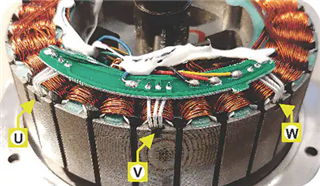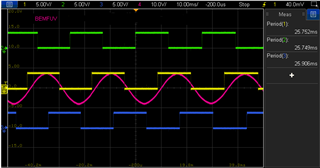I have a BLDC motor with Hall effect sensor feedback. The Hall sensors are located in the center of every tooth of the motor (Figure 1) based on mechanical and electrical degree calculation.
I have looked over related BEMF signal vs the Hall sensor output. There is no drive section, only spun the motor by hand, not too fast.
As far as I know, for example, if you look at BEMFUV (U+,V-), you should see the switch from low to high or high to low in every zero crossing point.
As you see, thoughthere is a significant delay between the Hall output and the BEMF zero crossing point. The periods of the Hall signals are the same. In every BEMF signal waveform, the same situation exists. (Figure 2)
Note: HALLU=Green, HALLV=Yellow, HALLW=Blue.
There is no offset in the Hall sensor placement for each 3 steps tooth of motor, centered placed.
What is the explanation for the delay between the Hall sensor output and the BEMF zero crossing point? How can I prevent this?
If the Hall sensors are not properly aligned we can use a delay function on microcontroller side. Is the delay normal or not?





